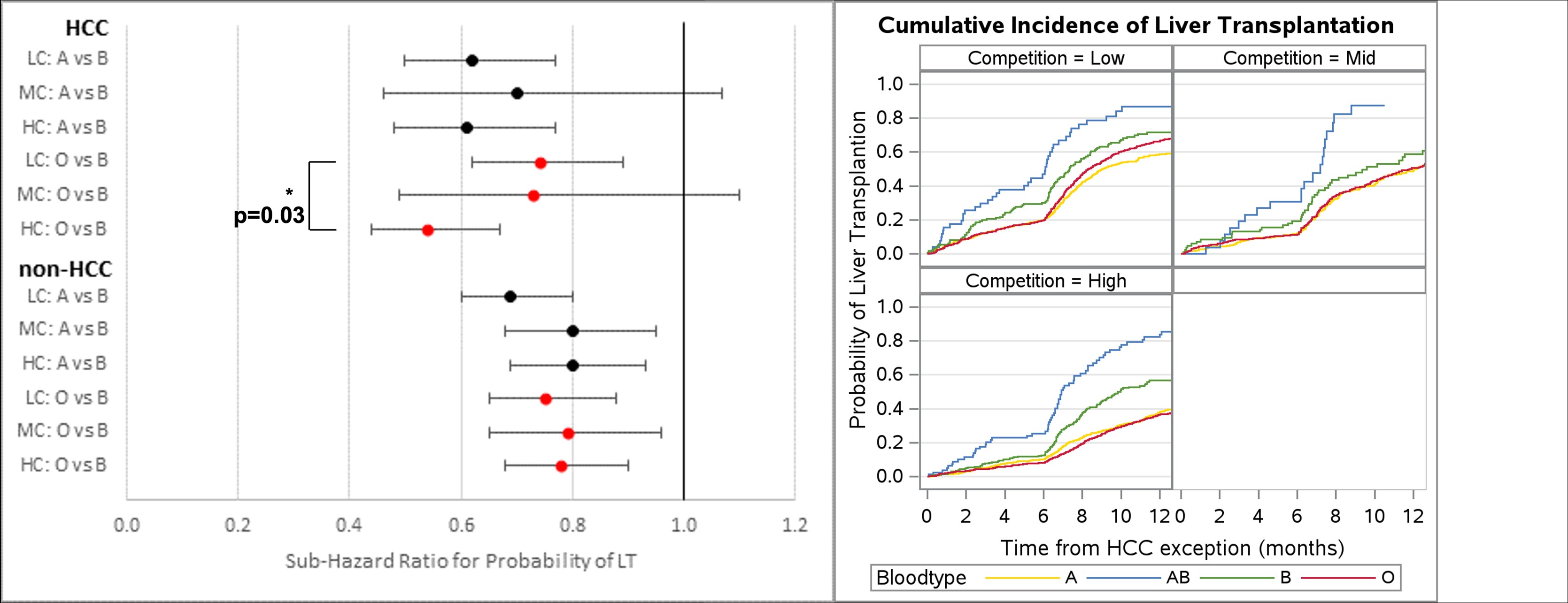Disparities in Liver Transplant Access for HCC Patients Based on Patient Blood Type and the Intensity of Competition for Organs Under MMAT-3
University of Southern California, Los Angeles, CA
Meeting: 2022 American Transplant Congress
Abstract number: 318
Keywords: Allocation, Hepatocellular carcinoma, Liver
Topic: Clinical Science » Liver » 60 - Liver: MELD Allocation*
Session Information
Session Name: MELD Allocation and Large Data
Session Type: Rapid Fire Oral Abstract
Date: Monday, June 6, 2022
Session Time: 5:30pm-7:00pm
 Presentation Time: 6:00pm-6:10pm
Presentation Time: 6:00pm-6:10pm
Location: Hynes Room 313
*Purpose: Recent policy changes (acuity circles and MMAT-3 for HCC MELD exception) aimed to reduce geographic disparities in access to liver transplant (LT) and mitigate the advantage for patients with HCC. However, we hypothesize these changes may have had differential impact on access for patients with HCC based on their blood type and the intensity of competition for organs. We aim to explore the impact of center-level competition and patient blood type on rates of LT after MMAT-3 implementation.
*Methods: We utilized the UNOS database, to identify adults listed for primary liver (and SLK) transplant from 5/14/2019 to 3/31/2021, which yielded 20,808 LT candidates. Patients with HCC MELD exception were identified (4172, 20.0%). We assigned center competition by the latest reported MMAT for each patients’ listing center, categorized into 3 groups: Low competition (LC, MMAT-25-28, 36%), Medium competition (MC, MMAT 29, 21.4%), and High competition (HC, MMAT 30-33, 42.6%). Median follow-up time was 4.2 months (IQR 0.5-10.1) from listing. The primary outcome was rate of LT examined with multivariable competing-risk regression. We stratified these models by HCC exception and tested the interaction between competition and patient blood type.
*Results: The probability of LT was lower in the HC vs LC group in both the HCC (sHR 0.5, 95% CI 0.4-0.66) and non-HCC cohorts (sHR 0.62, 95% CI 0.51-0.75). We also identified a significant disparity in LT rate for HCC patients with blood types O and A compared to blood types B and AB. HCC patients with blood type O were 40% less likely to undergo LT compared to B (sHR=0.60, 0.56-0.74) and 70% less likely when compared to AB (sHR=0.31, 0.25-0.37). Furthermore, this disparity was exacerbated by higher levels of competition. The LT probability disadvantage for O compared to B was more pronounced in the HC group when compared to the LC group (sHR 0.55 vs 0.74, interaction p=0.03) as well as for O compared to AB (sHR 0.25 vs 0.39; p=0.06). In the non-HCC group, the blood type disadvantage was also present, but not as great as the HCC group, and not different by competition (O vs B interaction p=0.74).
*Conclusions: Despite changes in allocation, disparities in LT access persist when comparing areas with low competition to high competition. Furthermore, disparities in access for HCC patients across blood groups have persisted. UNOS policy makers should consider setting the MMAT goals based on blood type to alleviate this disparity and consider mechanisms to increase access for HCC patients in HC areas.
To cite this abstract in AMA style:
Ahearn AJ, Chowdhry H, Dodge JL, Zhou K. Disparities in Liver Transplant Access for HCC Patients Based on Patient Blood Type and the Intensity of Competition for Organs Under MMAT-3 [abstract]. Am J Transplant. 2022; 22 (suppl 3). https://atcmeetingabstracts.com/abstract/disparities-in-liver-transplant-access-for-hcc-patients-based-on-patient-blood-type-and-the-intensity-of-competition-for-organs-under-mmat-3/. Accessed December 28, 2025.« Back to 2022 American Transplant Congress

